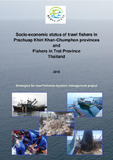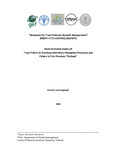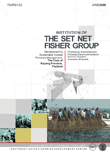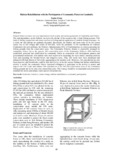| dc.contributor.author | Jumnongsong, Sirisuda PhD. | |
| dc.date.accessioned | 2020-04-07T05:58:28Z | |
| dc.date.available | 2020-04-07T05:58:28Z | |
| dc.date.issued | 2016 | |
| dc.identifier.citation | Jumnongsong, S. (2016). Socio-economic status of trawl fishers in Prachuap Khiri Khan-Chumphon provinces and Fishers in Trat Province Thailand . Training Department,Southeast Asian Fisheries Development Center. | en |
| dc.identifier.uri | http://hdl.handle.net/20.500.12067/1146 | |
| dc.description.abstract | This report has been prepared to support the implementation of the recommendations made by the REBYC-II CTI Project (Strategies for Trawl Fisheries Bycatch Management - GCP/RAS/269/GFF) by focusing on socio-economic aspects of fisheries in the two project pilot sites in Thailand. The works consisted of the following studies: (1) Socio-economic status of trawl fishers in Prachuap Khiri Khan-Chumphon provinces and (2) Socio-economic status of fishers in Trat province.
The primary objective of these two studies was to review existing socio-economic data and to study the socio-economic status of trawl fishers in Prachuap Khiri Khan-Chumphon provinces and fishers in Trat province. The existing socio-economic data were collected from DOF central and provincial offices, statistical records and other relevant agencies. Two sets of structured interview schedules were translated into Thai and used for interview survey with fishers in the two sites.
In the first study in Prachuap Khiri Khan-Chumphon provinces, 30 respondents including otter board trawl (OBT) fishing (63.3 percent), beam trawl (BT) fishing (20 percent) and pair trawl (PT) fishing (16.7 percent) were interviewed by the officers of CMDEC during the period of August - November 2014 at three main fishing ports. Seventy percent of respondents in the study had no second occupation. The mesh size of codend in the trawl-net of 87 percent of respondents was less than 4 cm (2-2.5 cm for PT, 2-3 cm for OBT and 3.8-4 cm for BT). The average price of trash fish per kg was THB 5.5 and the estimated income per trip from selling trash fish caught by BT, OBT and PT were THB 550, THB 13 365, and THB 110 000 respectively. The cost of fuel was perceived to be the highest single operational cost of trawl fishing by the respondents (67 percent of total cost). Most respondents (83 percent) were satisfied with the benefit returned from trawl fishing (more than half of the respondents were slightly satisfied) and 77 percent of respondents mentioned that they could continue trawl fishing.
In the second study in Trat province, 233 respondents including small-scale fishery households (83 percent) and medium to large-scale fishery households (17 percent) were interviewed by EMDEC staff during the period of September - October 2014 at the respondents’ houses. Most of the respondents (68 percent) had a single occupation, which was fishing. The main fishing gear used by small-scale households were shrimp trammel nets, crab gillnets and crab traps while for medium to large-scale households, push nets, trawls and purse seines were more common. Household incomes before deducting the cost of fishing were about seven times higher for medium to large-scale households compared to that for small-scale fishers households (THB 7 000 vs THB 1 000 per day). Nearly 60 percent of the respondents were moderately satisfied with the benefits from fishing in the study area. Most of the respondents (84 percent) believed that they could continue with their current fishing activities. An ordinal logistic regression was used to investigate differences in responses for the small-scale fishers and medium to large scale fishers for each of the 14 options and there were five options where there were statistically significant differences between the responses of the two groups. The small-scale fishery households were more likely to agree or strongly agree with option 5 (no use of some fishing gears in zone 2 and zone 3 in May-October), option 6 (No fishing in spawning season in zone 3 in February-May), option 7 (No use of any fishing gears having net mesh size smaller than 4.5cm), option 9 (Publicity campaign for no take fish larvae) and option 12 (Promote more and maintain crab bank project) than medium to large-scale fishery households.
The socio-economic status of fishers, and some key recommendations and lessons learned, are presented in this report. It is noted that the studies were conducted in 2014, prior the new fisheries law in Thailand entered into force in 2015. To compare the situations and examine the socio-economic impacts of the new fisheries law on fishers at the project sites, it is recommended that a similar study be conducted at a later period, using the results of these studies as a baseline. | en |
| dc.format.extent | 67 pages | en |
| dc.language.iso | en | en |
| dc.publisher | Training Department,Southeast Asian Fisheries Development Center | en |
| dc.subject | Trawl fishers | en |
| dc.subject | bycatch | en |
| dc.subject | Socio-economic | en |
| dc.title | Socio-economic status of trawl fishers in Prachuap Khiri Khan-Chumphon provinces and Fishers in Trat Province Thailand | en |
| dc.type | Technical Report | en |
| dc.contributor.corporateauthor | SEAFDEC | en |
| dc.contributor.corporateauthor | REBYC-II CTI | en |
| dc.contributor.corporateauthor | Kasetsart University | en |




